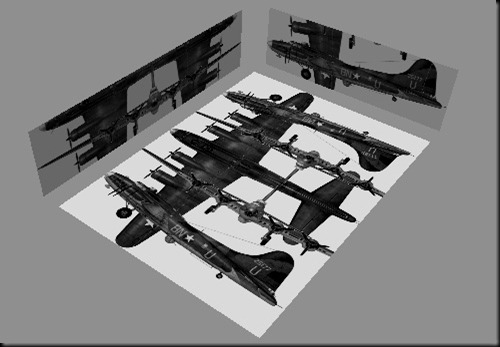If you wish to build a high quality vehicle model you will need good references before starting work. Sometimes I’ll read up a little on whatever I am building in order to gain some perspective and context for what I am building. In the case of the B-17 I have been reading information on this aircraft for decades and I have gone through more books on this subject than I might care to admit. While reading about your vehicle might not make you a better modeler it might create the psychological effect of putting you in the mood for your project.
One thing to consider before finding schematic 3 view images of your model is to determine the version type of the aircraft or other vehicle you wish to model. It isn’t enough to decide that you want to build a B-17 and start work. You need to decide what type of B-17 to build. B-17 types evolved from the original B-17A to the B-17G. Even inside these lettered classifications different production blocks would carry subtle changes. You need to get specific on what you intend to build. In my case I decided to model an early version of the B-17G. The B-17G Flying Fortress was the most mass produced version of the B-17 and the early version I decided to model had some elements in common with the B-17F. Now that I had scaled down what I wanted to build I could start some real research.
Downloading lots of interior and exterior images of the B-17G using Google Images was the first thing I did. I then picked up 3 view plans at The-Blueprints.com. As far as 3 view sites are concerned this is perhaps the best site I have run across in my years of modeling. Almost any vehicle you can imagine can be found here and in very high resolution sizes in many cases. With good 3 views I was able to put together my image planes for the model.
Ultimately I knew that I would need to texture the model and I found a nice profile representing my type of B-17 out at Wings Palette. This is my favorite site for finding useful profile skin ideas for military and civilian aircraft.
For many people this amount of reference would be enough to get started. I decided to go a step further. At Amazon.com I purchased A B-17 Flight Manual. Flight manuals can be very valuable in determining interior items as they would have looked like at the time the manual was written. Almost all B-17 interior photos on the internet are of currently flyable models and as a result they often carry some modern equipment or simply have removed wartime items. Flight manuals can help to differentiate an original interior from a new airshow or museum interior. A great site for finding flight manuals is eFlightManuals.com. I have relied on them a few times. In addition, through research on the internet, I managed to get hold of the original B-17G Parts Catalog that was issued to maintenance people during the war. I also got hold of the B-17F Erection and Maintenance Manual. These two manuals gave me about 1000 pages of tech illustrations of B-17 parts.
There are two other great ways to help in the creation process. One thing you can do is build a plastic model of the vehicle that interests you since sometimes it is nice to have a 3D visual reference in front of you to help out. In my case I bought a Revell-Monogram 1/48 scale B-17 model. The other thing you can do is visit one up close and personal. In addition to visiting airshows I have been to several air museums. Castle Air Museum in Atwater, CA provides a B-17G that I have walked around several times. There is another one close to the PerspectX offices at Hill Air Force Base. Seeing the real thing can be truly inspiring.






